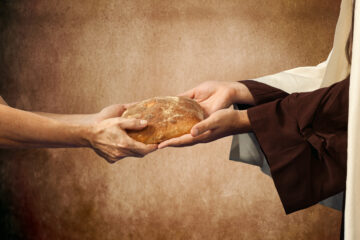Metropolitan of Pisidia Sotirios †
On September 14, the whole of the Orthodox world rejoices as we celebrate the Exaltation of the Holy Cross: “Behold, through the cross joy has come to the world!” (Paschal prayer)
Three historical events contributed to the establishment of this holiday:
1st. The discovery of the wood of the Holy Cross, in the year 326, by Saint Helen, mother of the Emperor Constantine the Great. When the Cross of the Lord was discovered near Golgotha and was miraculously identified as the true Cross of Christ, St. Helen worshiped it with tears and handed it over to Bishop Makarios of Jerusalem.
2nd. Saint Helen had laid the foundations of the Church of the Resurrection of the Lord over the site of the Holy Sepulchre, which was completed in the year 335, followed by its Inauguration. The next day, September 14 of the same year, the Elevation of the Holy Cross was held in the middle of the Church, with every ecclesiastical order, and everyone rushed to worship the Holy Cross with deep emotion and reverence.
3rd. After three centuries, the feast of the Exaltation of the Holy Cross was repeated once again. This is because, when the Persians invaded and conquered Jerusalem in 614, they snatched the Holy Cross from the Church of the Resurrection and held it for 14 years. In 628, the pious Emperor of Byzantium, Heraclius, defeated the Persians and returned the Holy Cross to Jerusalem. On September 14, 628, Emperor Heraclius, barefooted and in plain clothes, ascended to the Church of the Resurrection, in a procession, carrying the Holy Cross on his shoulders and handed it over to the Patriarch of Jerusalem Zacharias. The Patriarch received the Cross with deep emotion and raised it in the middle of the Church triumphantly, while all the faithful started singing together the hymn: “Save the Lord Your people and bless Your inheritance …”.
Since then, it has been established to officially celebrate the Exaltation of the Holy Cross throughout the Church, in both East and West.
The Holy Fathers of the Church, from the 4th century onwards, in their wonderful Sermons on the Holy Cross, highlight with many images and expressions the meaning of the Cross as well as the importance it bears in the life of the Church and of every believer.
Yet, we must clarify from the very beginning that the Cross does not carry any magical properties by itself. It derives all its value from the God-man Jesus Christ, who voluntarily was nailed to the Cross, upon which He shed His Holy Blood and sanctified it, thus making it a bearer of His Grace. That is why the God-inspired Fathers of the Church say: “When I honor the Cross, I admittedly honor Him, who was crucified on it. Moreover, when I honor the crucified Lord, I undeniably venerate the Cross. Let us, therefore, give due veneration to the Cross of Christ. Let us bend before Him our knees· (and even) much before that, ( let us) bend the ubending heart”. (1)
We, therefore, celebrate the great feast of the Holy Cross, and the whole congregation of the Church is enlightened and filled with rays of divine joy. The Cross is elevated, and together it elevates the whole of humanity, which had fallen down due to its sins. We are no more afraid of the fiery arrows of the devil, because the Holy Cross protects us. The Cross is a source of millions of blessings for us. The Cross is the hope of Christians, the savior of the desperate, a haven for those in difficult circumstances, a doctor for the sick; it removes sinful passions and sustains the Faith. (2)
The Cross is a ladder that ascends to Heaven. The Cross protects us from temptations, saves us from dangers, comforts us in sorrows, helps us in every need. The Cross protects widows and orphans. He who gazes at the Cross, is filled with courage and drives away cowardice. (3)
My beloved Brothers and Sisters, since the blood-stained Cross of the Lord provides us with all these and so many other blessings, let us be closely connected with it and let us often invoke its grace and power, in every need of ours.
Let us make the sign of the cross when we get up in the morning, thanking the Lord who blessed us to see the light of a new day. Let us begin and end our work with the sign of the cross. For every mercy we receive from God, let us thank Him by making our cross. Moreover, in every need of ours let us invoke the help and protection of our Almighty and Most Merciful Lord by making the sign of the cross; and let us rest assured that we, like many others, will see miracles in our lives.
(1) Nicetas the Paphlagonian, PG 105, 28-29.
(2) John Chrysostom, Homily on the Cross, and Homily B’. Migne P.G. 49 p.p. 407-418.
(3) St. Andrew of Crete, Homily A’ On the Elevation of the Holy and Life-giving Cross, PG 97, 1017-36.
Source: pemptousia.com




0 Comments